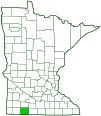Geyer’s aster
(Symphyotrichum laeve var. geyeri)
Conservation • Wetland • Description • Habitat • Ecology • Use • Distribution • Taxonomy
Conservation Status |
|
|||||||
| IUCN Red List | not listed |
|||||||
| NatureServe | NNR - Unranked SNR - Unranked |
|||||||
| Minnesota | not listed |
|||||||
Wetland Indicator Status |
||||||||
| Great Plains | FACU - Facultative upland |
|||||||
| Midwest | FACU - Facultative upland |
|||||||
| Northcentral & Northeast | FACU - Facultative upland |
|||||||
Description |
||
The stem is smooth and hairless or nearly hairless, reddish, and often covered with a whitish, waxy bloom (glaucous). Lower stem leaves are on winged petioles. The base of the leaf is never heart-shaped. Middle stem leaves clasp the stem at the base and are less than 5 times as long as wide. Upper stem leaves are stalkless. The upper and lower leaf surfaces are smooth and hairless or nearly hairless. They sometimes have a grayish or bluish tint. The bracts of the involucre (phyllaries) have a long, green, lance-shaped tip. The flower head has 15 to 30 lavender, light blue, or purple ray florets. The tuft of feathery hairs at the tip of the achene (pappus) is usually light brown, often reddish. |
||
Height |
||
12″ to 36″ |
||
Flower Color |
||
Blue to purple |
||
Similar Species |
||
Common smooth blue aster (Symphyotrichum laeve var. laeve) green tips of the phyllaries are diamond-shaped, not lance-shaped. |
||
Habitat |
||
Dry to moderate moisture. Prairies, woods. Full to partial sun. |
||
Ecology |
||
Flowering |
||
August to October |
||
Pests and Diseases |
||
|
||
Use |
||
|
||
Distribution |
||||
|
Sources |
|||
| 6/18/2023 | ||||
Nativity |
||||
Native |
||||
Occurrence |
||||
|
||||
Taxonomy |
|||
| Kingdom | Plantae (green algae and land plants) | ||
| Subkingdom | Viridiplantae (green plants) | ||
| Infrakingdom | Streptophyta (land plants and green algae) | ||
| Superdivision | Embryophyta (land plants) | ||
| Division | Tracheophyta (vascular plants) | ||
| Subdivision | Spermatophytina (seed plants) / Angiospermae (flowering plants) | ||
| Class | Magnoliopsida (flowering plants) | ||
| Superorder | Asteranae | ||
Order |
Asterales (sunflowers, bellflowers, fanflowers, and allies) | ||
Family |
Asteraceae (sunflowers, daisies, asters, and allies) | ||
| Subfamily | Asteroideae | ||
| Supertribe | Asterodae | ||
| Tribe | Astereae (asters and allies) | ||
| Subtribe | Symphyotrichinae | ||
| Genus | Symphyotrichum (American asters) | ||
| Subgenus | Symphyotrichum (common American asters) | ||
| Section | Symphyotrichum (bushy, eastern, heart-leaved, and old field asters) | ||
| Subsection | Heterophylli (heart-leaf panicled asters) | ||
| Species | Symphyotrichum laeve (smooth blue aster) | ||
Subordinate Taxa |
|||
|
|||
Synonyms |
|||
Aster geyeri Aster laevis var. geyeri Aster laevis var. guadalupensis Aster pickettianus |
|||
Common Names |
|||
Geyer’s aster |
|||
Glossary
Bract
Modified leaf at the base of a flower stalk, flower cluster, or inflorescence.
Clasping
Describing a leaf that wholly or partly surrounds the stem but does not fuse at the base.
Glaucous
Pale green or bluish gray due to a whitish, powdery or waxy film, as on a plum or a grape.
Involucre
A whorl of bracts beneath or surrounding a flower, flower head, or flower cluster.
Pappus
The modified calyx composed of awns, scales, bristles, or feather-like hairs in plants of the Asteraceae family.
Phyllary
An individual bract within the involucre of a plant in the Asteraceae family.
Visitor Photos |
|||||
Share your photo of this plant. |
|||||
| This button not working for you? Simply email us at info@MinnesotaSeasons.com. Attach one or more photos and, if you like, a caption. |
|||||
|
|||||
MinnesotaSeasons.com Photos |
|||||
|
|||||

Slideshows |
||

Visitor Videos |
|||
Share your video of this plant. |
|||
| This button not working for you? Simply email us at info@MinnesotaSeasons.com. Attach a video, a YouTube link, or a cloud storage link. |
|||
Other Videos |
|||

Visitor Sightings |
|||||
Report a sighting of this plant. |
|||||
| This button not working for you? Simply email us at info@MinnesotaSeasons.com. Be sure to include a location. |
|||||
|
|||||
MinnesotaSeasons.com Sightings |
|||||

|
Created: Last Updated: © MinnesotaSeasons.com. All rights reserved. |
